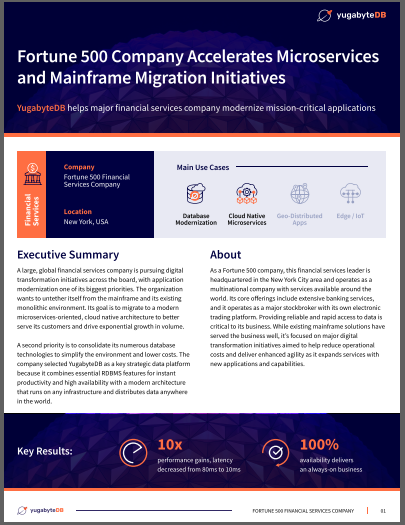Fortune 500 Financial Services Company Chooses YugabyteDB to Support Microservices and Mainframe Migration Initiatives
Situation
A large, global financial services company is pursuing digital transformation initiatives across the board, with one of its biggest priorities being application modernization. The bank wants to untether itself from the mainframe and its existing monolithic environment and migrate to a modern microservices-oriented, cloud native architecture to better serve its customers and support its growth goals.
A second priority is to consolidate the numerous database technologies to simplify their environment and lower costs. One of their chief leaders explained, “We don’t need all of these databases, we just need to have a few cloud native databases that do the things we need them to do.” Additionally, the company aims to keep the door open for potentially using public cloud resources in the future.
Challenge
The company needed to innovate at a quicker pace, while still being able to provide global customers with the always available financial products and services they need. This is a challenging endeavor, given there are many such products and services that need to be made cloud native. They kicked this process off by identifying a critical business application that manages customer data and accounts online, which was experiencing performance bottlenecks.
Provisioning and maintaining the existing DB2 data infrastructure on the mainframe was operationally complex and was slowing down the innovation of new features. Making DB2 highly available on the mainframe involved very expensive replication technology and was still not able to provide strongly consistent data across data centers. In addition, the company wanted to open the door to leveraging the public cloud in the future, which is something they could not do with DB2 on the mainframe. The financial institution needed to take a fresh look at their underlying data tier, and looked to distributed SQL database vendors for help.
Database Requirements
- High availability for a service that manages trillions of dollars in assets
- Support for essential RDBMS features, plus async replication
- Distributed by design and can be deployed across data centers and the public cloud
- Strong data consistency and ACID compliance for distributed transactions
- Active-active deployment with sustained low latencies while handling high throughput updates
- Strong suite of security features, such as integration with volume-level encryption from industry leading vendors
Yugabyte Solution
The company chose YugabyteDB as the distributed SQL database to power their customer accounts service, with plans to move even more microservices on top of YugabyteDB in the future. YugabyteDB is an open source, distributed SQL database designed to be highly resilient to failures and horizontally scalable. It’s PostgreSQL compatible, and built to run across private and public clouds.
Having successfully deployed in Q3 of 2020, the company is already seeing positive results. They went into production with an internal facing use case first and will be transitioning over several more microservices to YugabyteDB soon. After a few additional months with the new database solution, they will retire the legacy system that is currently running in parallel and completely switching over to the new system powered exclusively by YugabyteDB.
Key Technical Results
- Zero downtime
- 10x performance gain—latency decreased from 80 to 10 milliseconds
- Implemented cloud native architecture stack with YugabyteDB and Spring microservices
Key Business Results
- Enabled the company to meet its primary goals:
- Migrating away from the mainframe
- Maintaining uptime and improving performance
- Moving to microservices
- Deploying anywhere – hybrid deployments using a combination of data centers and nearby public cloud regions
- Improved productivity – rather than being slowed down waiting for provisioning and maintenance of DB2 on the mainframe, the application team can quickly deploy YugabyteDB anywhere, and it automatically scales as needed
- Reduced costs by transitioning workloads to commodity hardware vs mainframes
A chief leader at the company commented, “There are no other existing database platforms that are active/active, can provide low latency, and lower costs.”
What’s Next
As noted in a presentation on Mainframe Modernization by Wipro Digital, 71 of the Fortune 500 companies use mainframes, 68% of the world’s production workloads run on mainframes, and 92 of the world’s top 100 banking, financial services, and insurance workloads run on mainframes. Many of these companies are looking to modernize their applications and underlying infrastructure to take advantage of new paradigms, including microservices, cloud infrastructure, and distributed computing.
Financial institutions and other organizations looking to move away from the mainframe can use YugabyteDB to help. It combines RDBMS features for instant productivity, high availability to power always-on services, and the additional benefits of a modern database: the ability to run on any infrastructure and to distribute data anywhere in the world.
 Want to know more? Read our full customer success story to discover why YugabyteDB is the ideal database choice for banking and financial services providers.
Want to know more? Read our full customer success story to discover why YugabyteDB is the ideal database choice for banking and financial services providers.


